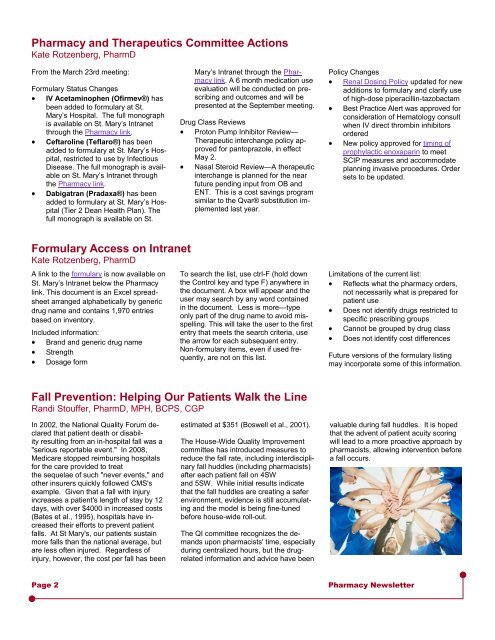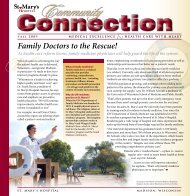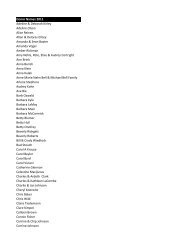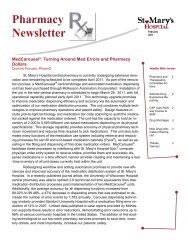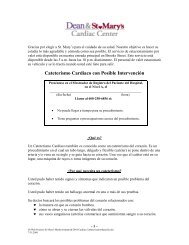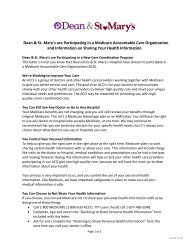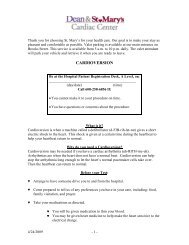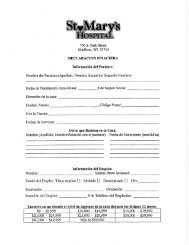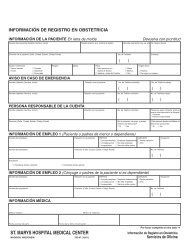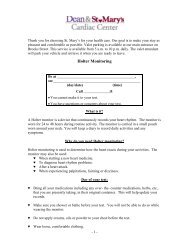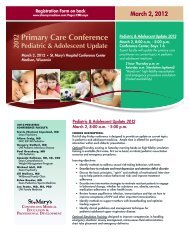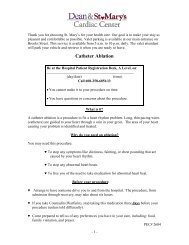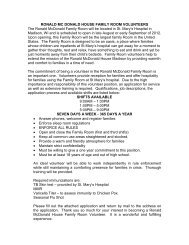link-Pharmacy Newsletter 052011 - St. Mary's Hospital
link-Pharmacy Newsletter 052011 - St. Mary's Hospital
link-Pharmacy Newsletter 052011 - St. Mary's Hospital
Create successful ePaper yourself
Turn your PDF publications into a flip-book with our unique Google optimized e-Paper software.
<strong>Pharmacy</strong> and Therapeutics Committee Actions<br />
Kate Rotzenberg, PharmD<br />
From the March 23rd meeting:<br />
Formulary <strong>St</strong>atus Changes<br />
IV Acetaminophen (Ofirmev®) has<br />
been added to formulary at <strong>St</strong>.<br />
Mary’s <strong>Hospital</strong>. The full monograph<br />
is available on <strong>St</strong>. Mary’s Intranet<br />
through the <strong>Pharmacy</strong> <strong>link</strong>.<br />
Ceftaroline (Teflaro®) has been<br />
added to formulary at <strong>St</strong>. Mary’s <strong>Hospital</strong>,<br />
restricted to use by Infectious<br />
Disease. The full monograph is available<br />
on <strong>St</strong>. Mary’s Intranet through<br />
the <strong>Pharmacy</strong> <strong>link</strong>.<br />
Dabigatran (Pradaxa®) has been<br />
added to formulary at <strong>St</strong>. Mary’s <strong>Hospital</strong><br />
(Tier 2 Dean Health Plan). The<br />
full monograph is available on <strong>St</strong>.<br />
Mary’s Intranet through the <strong>Pharmacy</strong><br />
<strong>link</strong>. A 6 month medication use<br />
evaluation will be conducted on prescribing<br />
and outcomes and will be<br />
presented at the September meeting.<br />
Drug Class Reviews<br />
Proton Pump Inhibitor Review—<br />
Therapeutic interchange policy approved<br />
for pantoprazole, in effect<br />
May 2.<br />
Nasal <strong>St</strong>eroid Review—A therapeutic<br />
interchange is planned for the near<br />
future pending input from OB and<br />
ENT. This is a cost savings program<br />
similar to the Qvar® substitution implemented<br />
last year.<br />
Policy Changes<br />
Renal Dosing Policy updated for new<br />
additions to formulary and clarify use<br />
of high-dose piperacillin-tazobactam<br />
Best Practice Alert was approved for<br />
consideration of Hematology consult<br />
when IV direct thrombin inhibitors<br />
ordered<br />
New policy approved for timing of<br />
prophylactic enoxaparin to meet<br />
SCIP measures and accommodate<br />
planning invasive procedures. Order<br />
sets to be updated.<br />
Formulary Access on Intranet<br />
Kate Rotzenberg, PharmD<br />
A <strong>link</strong> to the formulary is now available on<br />
<strong>St</strong>. Mary’s Intranet below the <strong>Pharmacy</strong><br />
<strong>link</strong>. This document is an Excel spreadsheet<br />
arranged alphabetically by generic<br />
drug name and contains 1,970 entries<br />
based on inventory.<br />
Included information:<br />
Brand and generic drug name<br />
<strong>St</strong>rength<br />
Dosage form<br />
To search the list, use ctrl-F (hold down<br />
the Control key and type F) anywhere in<br />
the document. A box will appear and the<br />
user may search by any word contained<br />
in the document. Less is more—type<br />
only part of the drug name to avoid misspelling.<br />
This will take the user to the first<br />
entry that meets the search criteria, use<br />
the arrow for each subsequent entry.<br />
Non-formulary items, even if used frequently,<br />
are not on this list.<br />
Limitations of the current list:<br />
Reflects what the pharmacy orders,<br />
not necessarily what is prepared for<br />
patient use<br />
Does not identify drugs restricted to<br />
specific prescribing groups<br />
Cannot be grouped by drug class<br />
Does not identify cost differences<br />
Future versions of the formulary listing<br />
may incorporate some of this information.<br />
Fall Prevention: Helping Our Patients Walk the Line<br />
Randi <strong>St</strong>ouffer, PharmD, MPH, BCPS, CGP<br />
In 2002, the National Quality Forum declared<br />
that patient death or disability<br />
resulting from an in-hospital fall was a<br />
"serious reportable event." In 2008,<br />
Medicare stopped reimbursing hospitals<br />
for the care provided to treat<br />
the sequelae of such "never events," and<br />
other insurers quickly followed CMS's<br />
example. Given that a fall with injury<br />
increases a patient's length of stay by 12<br />
days, with over $4000 in increased costs<br />
(Bates et al., 1995), hospitals have increased<br />
their efforts to prevent patient<br />
falls. At <strong>St</strong> <strong>Mary's</strong>, our patients sustain<br />
more falls than the national average, but<br />
are less often injured. Regardless of<br />
injury, however, the cost per fall has been<br />
estimated at $351 (Boswell et al., 2001).<br />
The House-Wide Quality Improvement<br />
committee has introduced measures to<br />
reduce the fall rate, including interdisciplinary<br />
fall huddles (including pharmacists)<br />
after each patient fall on 4SW<br />
and 5SW. While initial results indicate<br />
that the fall huddles are creating a safer<br />
environment, evidence is still accumulating<br />
and the model is being fine-tuned<br />
before house-wide roll-out.<br />
The QI committee recognizes the demands<br />
upon pharmacists' time, especially<br />
during centralized hours, but the drugrelated<br />
information and advice have been<br />
valuable during fall huddles. It is hoped<br />
that the advent of patient acuity scoring<br />
will lead to a more proactive approach by<br />
pharmacists, allowing intervention before<br />
a fall occurs.<br />
Page 2<br />
<strong>Pharmacy</strong> <strong>Newsletter</strong>


